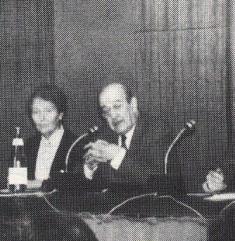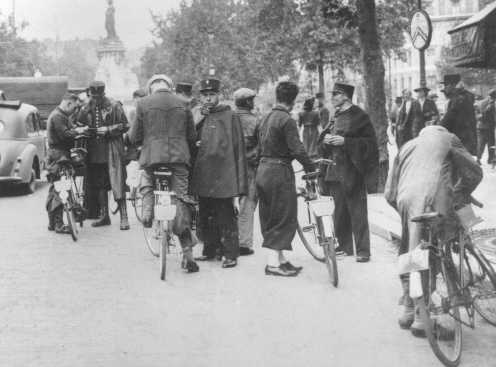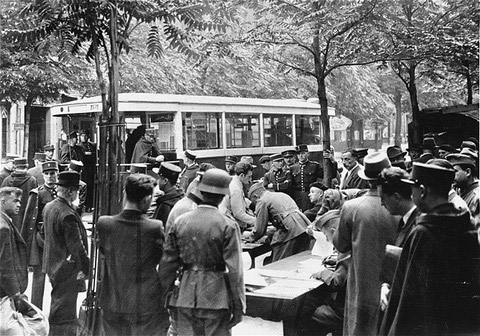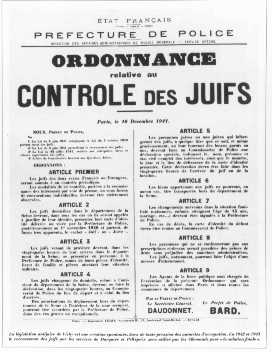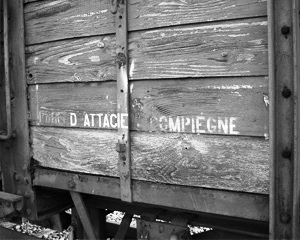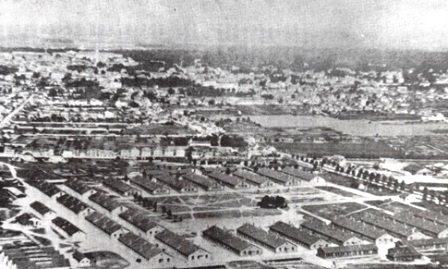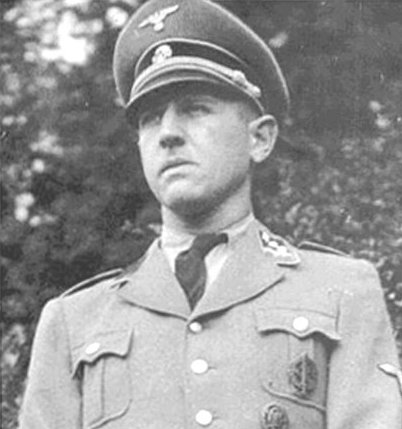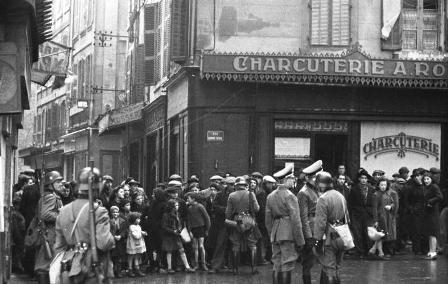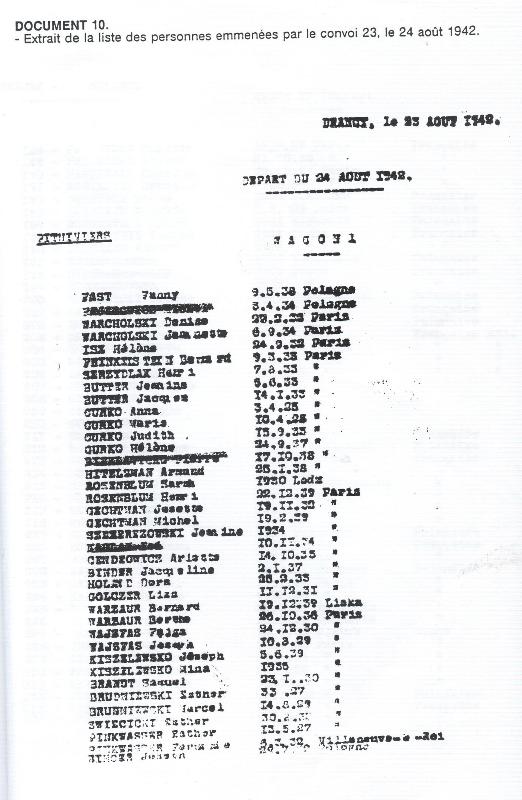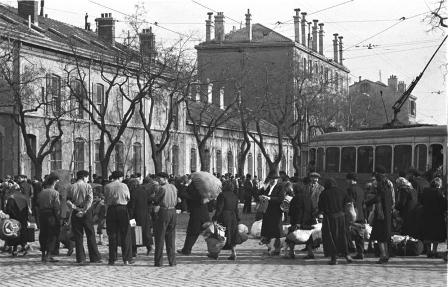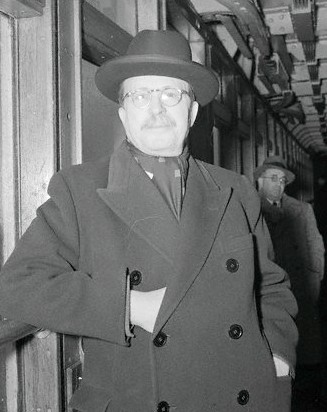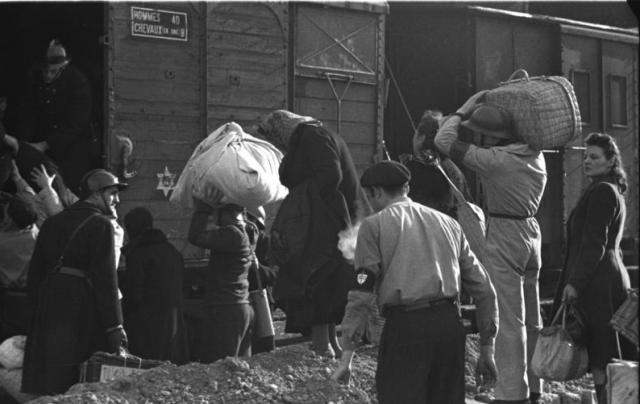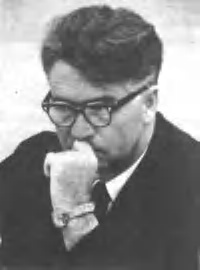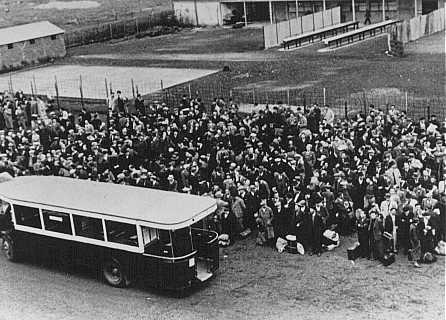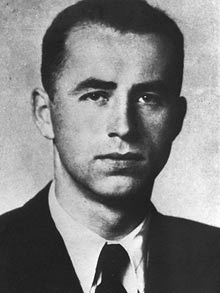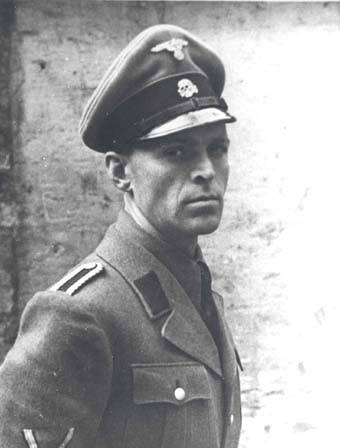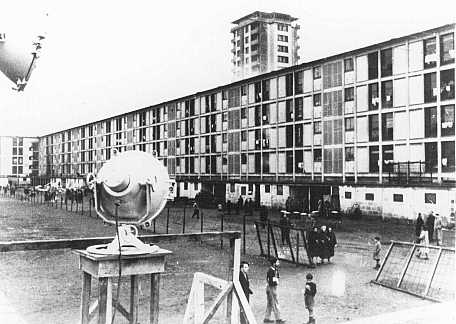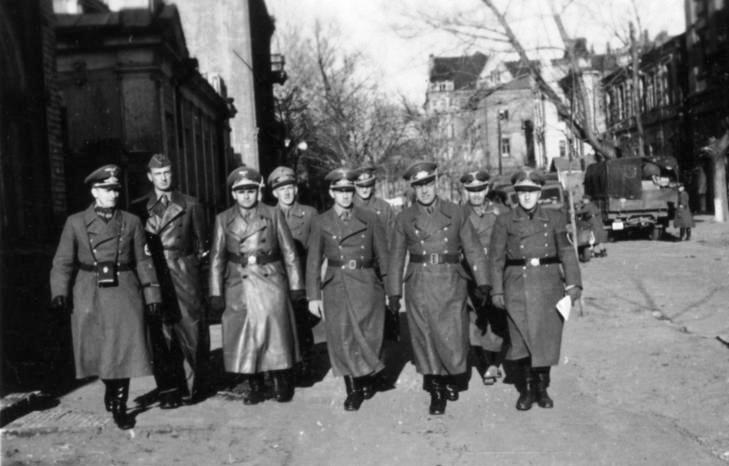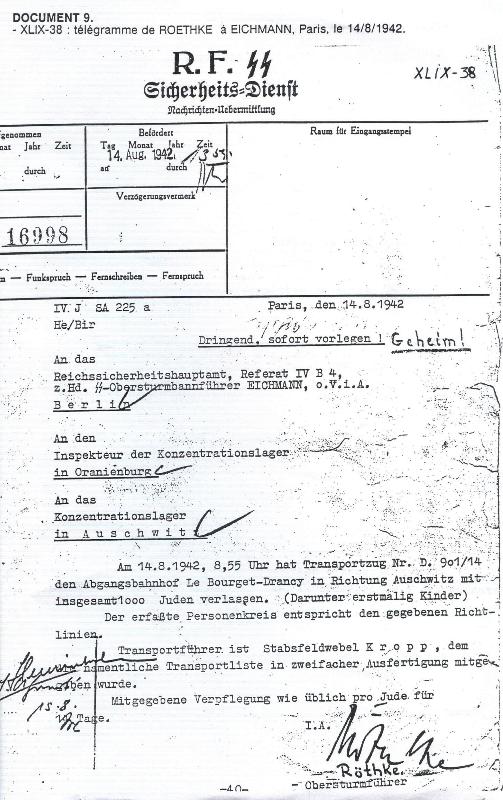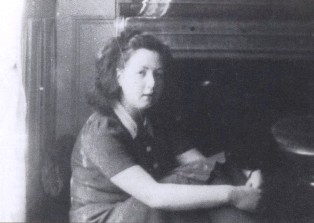Holocaust Education & Archive Research Team |
|
Trials Introduction to the Holocaust Trials
Trials
Interrogations & Testimonies
The IMT Series Nazi Justice
| ||||||||||||||
George Wellers Testimony about Conditions in France & Deportations from France At the Eichmann Trial 9 May 1961 (Selected Extracts)
Presiding Judge: What is his full name?
Witness: George Wellers
Presiding Judge: Please answer the questions put to you by Mr Bach
Answer: Yes
State Attorney: Where are you now living?
Answer: 6 Rue du Loing in Paris
Question: And what is your occupation?
Answer: I am Maitre de Recherches (Senior Researcher) at the National Centre for Scientific Research
Question: You also work at the Faculty of Medicine at the Sorbonne, don’t you?
Answer: Yes, I work at the Faculty of Medicine at the Sorbonne
Question: In what capacity?
Answer: I direct a laboratory of physiological research
Question: You were awarded a prize of the Academy of Medicine, weren’t you?
Answer: Yes
Question: Where were you born, Mr Wellers?
Answer: I was born in Koslov in Russia
Question: And when did you arrive in France?
Answer: In 1929
Question: You got married in Latvia and have two children?
Answer: Yes Question: You have been a French citizen since 1938?
Answer: Yes
Question: In 1939 you joined the French Army when the war broke out?
Answer: Yes
Question: Where were you in June 1940, when the Germans occupied France?
Answer: In the Bordeaux region
Question: And you were then released from the army and returned to Paris?
Answer: Yes
Question: And you went back to your work in the physiological laboratory at the Faculty of Medicine?
Answer: Yes
Question: Mr Wellers, which was the first razzia (round-up) carried out by the Germans against the Jews in France?
Answer: Well, the first major round –up took place in May 1941
Question: Who were the people arrested on that occasion?
Answer: Foreigners – the German, Austrian, Polish and Czechoslovakian Jews in Paris. They were asked to go to the Police station to check their civil status, and when they showed up they were arrested. These were all men, adult men.
Question: Where were these people taken?
Answer: They were taken to the Orleans region, a hundred kilometres to the South of Paris, to two camps called Beaune- la- Rolande and Pithviers. Those were the first two camps which were set up.
Question: When was the second time Jews were arrested?
Answer: The second great round-up took place on the 2 of August 1941 in Paris. They combed the 11th arrondissment of the capital which had the densest Jewish population, and in one day – going to one house after another, one shop after another, and checking the personal documents of passers-by in the streets – they arrested all the Jews, all able-bodied men.
I forgot to point out that, in the course of these arrests, about 4,000 people were arrested, and in August, about 6,000 and in addition, in the city, outside the 11th arrondisement, they arrested about forty of the most prominent advocates, including Pierre Masse, for instance, a very well known lawyer who formerly, in Clemenceau’s time had been a Minister.
Question: Which camp were these people taken to?
Answer: They were taken to the Paris suburbs, to the suburb called Drancy. They were put into a place which was a kind of “city” – a collection of buildings forming a square with an interior courtyard.
The buildings were not yet completed, so that the staircase led to large rooms of somewhat strange appearance. Each of them was to contain two or three apartments.
Presiding Judge: Was he at the place he has described?
Witness Wellers: No, not at that time, but I arrived there a few months later.
State Attorney Bach: Mr Wellers, when were Jews required to register as Jews in Paris?
Witness Wellers: It was a German ordinance signed by the Millitar- Befehlshaber in Frankreich (Officer Commanding the Military Forces in France) and dated 27 September 1940.
A short time afterwards – I think two or three days afterwards- there appeared in the French press – which at that time we called the German press in the French language – an announcement of Petain’s Police giving a timetable of the dates at which people had to present themselves for registration in alphabetical order. Thus, I personally was called on 19 October 1940.
Question: Mr Wellers, could you please tell us briefly how you registered, and also tell us what particulars you gave in the case of your wife?
Answer: Well, one had to present oneself and to declare oneself and one’s children. I declared myself as Jewish and I declared my children as Jewish, but I did not declare my wife, which was tantamount to declaring her as non-Jewish.
Question: When were you arrested Mr Wellers?
Answer: I was arrested on 12 December 1941
Question: By whom?
Answer: By a single policeman who came to my home at five or six in the morning.
Question: A policeman?
Answer: One single German policeman
Question: And you were taken first to the Ecole Militaire (Military Academy) in Paris?
Answer: Yes
Question: When you were taken there, what explanation was given to you and to the others concerning your arrest?
Answer: Well, we were received by a group of SS men who received us shouting and joking. They told us that on the previous day, 11 December, Hitler had made a speech in which he had stated that Germany had declared war on the United States, and as Hitler had previously declared that if there was another war, it was the Jews who would pay for it, it was these Jews who would pay for the entry of the United States into the war.
Presiding Judge: Did Hitler declare war on the United States? I think the United States declared war on Germany.
Witness Wellers: No, I think it was Germany which declared war on the United States.
State Attorney Bach: After the Japanese attack on the United States, Hitler declared war on America. This is what I remember.
Witness Wellers: Might I just add something?
State Attorney Bach: Please do.
Witness Wellers: I wanted to say that this arrest was clearly a selection. They went to the homes of each of us separately; there were 750 of us, and this included a large number of very well-known people – many lawyers, many intellectuals in general – so that there was a certain resemblance among those that were selected. It would seem that we had been specially selected, each one individually.
State Attorney Bach: You and the 750 other Jews were taken to the camp at Compiegne?
Answer: Yes
Question: Who guarded the camp?
Answer: The camp was guarded by the Wehrmacht, its official name was Frontstalag 122; it was divided into three parts, separated by barbed wire fences.
In one part there were Russians who had been arrested in June 1941 when Germany attacked the Soviet Union; there were Soviet Russians, as well as émigré Russians, White Russians and there were many Jews amongst them.
Another part, again separated by barbed wire fences, was occupied by Frenchmen who were syndicalists, communists and socialists; and then there was a third part which had been unoccupied before our arrival and which was occupied by us, and that was the Jewish camp.
Question: You are saying that there were really a number of different camps, and one camp amongst them was set aside for Jews. How were the prisoners in this camp, the Jewish camp, treated as compared with the treatment given to the prisoners in the adjoining camps?
Answer: Well, the rules were as follows, in the Russian camp and the French camp the prisoners were allowed correspondence and had the right to receive parcels and to have visitors.
But as for us, we were kept in isolation; we were neither allowed to write, nor naturally, to have visitors, nor to receive any parcels. Theoretically, our families were not supposed to know where we were, but in practice – thanks to the magnificent solidarity of the Russian and French camps next to us – we were able quite soon to send out secret letters so that our families were informed, but officially we were kept in total isolation for three months until 12 March 1942.
Question: Do you know if your wife tried to approach the Red Cross in order to send a letter to you?
Answer: Yes, but they refused to give her any answer whatsoever.
Question: Did the letter reach you somehow or other?
Answer: The official letter?
Question: The letter which your wife tried to send to you through the Red Cross?
Answer: No, I never received any official letter from my wife and she never asked for a letter to be sent to me. She asked the Red Cross to inform her where I was. They refused to give her any information.
Question: When did you first see the SS Officer Dannecker?
Answer: I saw him on 12 December 1941 when we were assembled in the Riding School of the Ecole Militaire in Paris, before we were taken to Compiegne, on the day of our arrest.
He arrived, I think, at about four or five in the afternoon and came into the Riding School accompanied by a small group of Germans in uniform. He walked across the Riding School, and at that moment he noticed two of us who were wearing French uniforms – one was a military physician who had been arrested at his place of work where he was wearing his uniform, and the other was a fireman wearing a fireman’s uniform.
Then Dannecker stopped in front of them and addressed them, shouting very loudly; some curious people came up, and then Dannecker took out his revolver and shouted that he would shoot any Jew who came near him, and then he ordered the two prisoners in uniform to be removed.
They were taken away, and perhaps an hour later they were brought back dressed in ordinary clothes. They had been taken home to change, because Dannecker did not want any French uniforms among these prisoners.
Question: Where were the first Jews sent from Compiegne to Auschwitz?
Answer: On 27 March 1942 (1)
Question: When did Dannecker first arrive in Compiegne?
Answer: I first saw Dannecker on the night of the 12th to the 13th of December when we were taken to the camp. He was waiting for us at the entrance to the camp. Then he returned I think three, or four days later, and then I saw him again on 12 March 1942, when he came with a whole group of Germans, including Lieutenant – Colonel Pelzer who was commandant of all the camps at Compiegne and Captain Nachtigal who was the commandant of the camp at Compiegne in which we were. It was a German commission headed by Dannecker.
Question: When you saw Dannecker in the camp, who did you think he was?
Answer: We were convinced that he was the head of the Jewish section of the Gestapo for France and Belgium
Question: In what way could you see his influence in the things that were done in the camp?
Answer: In the camp at Compiegne?
Question: Perhaps in a wider sense both at Compiegne and also at Drancy?
Answer: Well, he was a man who was perpetually under pressure, perpetually in a rage. He reached for his revolver very easily, he shouted very easily when he came to Drancy (for three months he hardly went to Compiegne at all).
Several times for instance, when he came to Drancy, the order was given that nobody was to be in the courtyard of the camp and nobody was to look out of the windows. When Dannecker was walking in the courtyard, as soon as he saw a face in the window, he threatened the face which he saw.
He sometimes came up into the rooms and I know I have been personally present at the deportation of a few people who had been picked out by Dannecker at the last minute just as the convoy was leaving the camp; people were brought in on Dannecker’s personal orders and added to the convoy. He was a man who was undoubtedly an evil spirit in the camps in which I saw him.
Question: Can you recall the names of any people who were deported as a result of Dannecker’s direct intervention?
Answer: Yes, it was on 29 April 1942. There was a convoy which was leaving and which included myself; the column was just leaving the camp. Dannecker was present. At that moment he went and made a short visit. I saw him disappear into the buildings, and a few minutes later I saw four people coming up at great speed. They were Maitre Pierre Masse, his brother Roger Masse, Maitre Francois Montel and Maitre Albert Ulmeau, all of whom I knew very intimately.
Their heads were shaved at once in front of us. They were searched in the middle of the courtyard and were added to our convoy. They were three lawyers, and Roger Masse who was not a lawyer.
Question: Since this has some importance, who was Roger Masse?
Answer: Roger Masse was a former student of the Ecole Polytechnique, one of the outstanding technical institutes in France. The engineers who graduated from this school were, at that period, mainly military engineers so he was a Colonel and had the rank of Colonel in the French Army.
He had naturally been mobilised in 1939, and in 1940 he was taken prisoner, he was in an Oflag (Officers Camp) in Germany, and if I am not mistaken, in August 1941 he was set free by the Germans as a former combatant of the 1914 – 1918 war, seeing that he was already quite old.
He was not the only one, I have known other combatants of the 1914 -1918 war who were also set free by the Germans. He consequently arrived in Paris in August 1941 and on 12 December 1941, a few months later, he was arrested as a Jew, as I was. That is what I am able to tell you about Roger Masse.
Question: Before we go back to him, was he afterwards taken to Auschwitz?
Answer: Yes Question: Did he also die there?
Answer: Undoubtedly. With regard to his deportation, this is what I am able to tell you. On 29 April 1942 we were with the two Masse brothers, and we were once again taken to Compiegne from where we had previously arrived at Drancy.
Question: In short, Mr Wellers, would it be true to say that you were brought to Drancy from Compiegne and were not taken in the first transport because you were registered as the husband of an Aryan wife?
Answer: Yes
Question: In that first transport of 27 March 1942, how many people were taken?
Answer: Well, at Compiegne, there were about 550 who were deported on 27 March, and when they arrived at the station at Compiegne there was already a train waiting for them in which there were another 500 people who had come from Drancy, and consequently there were 1,000 people in the transport as always.
Question: Mr Wellers, from the time you reached Drancy in June 1942 until you were sent to Auschwitz, apart from a certain period when you worked at “Einsatzstab Rosenberg” (Special Operations Staff Rosenberg) you were in the camp at Drancy?
Answer: Yes
Question: While you were at Drancy, how many deportations from the camp did you actually see?
Answer: I think between forty and fifty
Question: How many people were deported on each occasion?
Answer: Between 1,000 and 1,200
Presiding Judge: Was Drancy a camp solely for Jews or also for others?
Witness Wellers: No, solely for Jews
State Attorney Bach: Did you sometimes see Dannecker while the deportations were in progress?
Answer: Yes
Question: Did Dannecker have any influence on conditions in the camp with regard to an improvement or worsening of conditions?
Answer: I think so, because Dannecker had the role, he conducted himself, as absolute master of the camp, and for us nobody was more important than Dannecker.
Question: Mr Wellers, did you know where the Jews deported from the camp were sent to?
Answer: No, not at all
Question: You sometimes received postcards from the people who were deported?
Answer: I believe that in January 1943 I saw three cards which reached the camp at Drancy and which were addressed to people who were supposed to be in Drancy at that period but had already been deported, so that the intended recipients were no longer there.
These three cards were written in more or less identical terms on each occasion, and the senders – who wrote from a place marked Birkenau, and it was the first time I had heard that name, which meant nothing whatsoever to me or to anyone else in the camp – each of the senders asked his family to send him, if I remember rightly, 40 Marks, a parcel of clothes and letters.
One of these cards was accompanied by a letter of the commandant of the Paris region – a General who had the title of Commandant of “Gross- Paris” – and in this letter it was stated that money and parcels were not permitted, and, as for letters, they could be sent via the commandant of the Paris region. In these postcards, the writers stated that they were living in very good conditions, they were very pleased with their way of life, and they were working in a very satisfactory manner.
Question: Mr Wellers, do you recall the events of the 16th and 17th of July 1942?
Answer: Yes
Question: Who were the people who were arrested on those days?
Answer: Foreigners in the Paris region – in the city, in the inner suburbs; only foreigners, of all kinds of nationalities. They were men, women and children aged from two to sixty.
Question: Where were these people taken at first?
Answer: Some of them – I must point out that at that time I was in the camp at Drancy, so on the night between the 16th and 17th of July I saw men and women arriving in the camp with adolescents of over twelve years of age; they were all taken to Drancy on that very day – and they told me that the people who had been arrested with children aged from two to twelve had been sent directly to the Paris Velodrome d’Hiver, a sports stadium especially for cycling events situated in the centre of the city, very near the Eiffel Tower.
Presiding Judge: When you say foreign citizens, you are referring to Jews?
Witness Wellers: Solely
State Attorney Bach: What happened to the people who had children of over twelve years of age?
Witness Wellers: These children remained a relatively short time at Drancy. They were arrested on 16 and 17 July and on 19 July there was already the first deportation of the people in Drancy who were of that group.
All the others were deported during approximately the two following weeks, because at that time – and that lasted about two months – there were three departures a week from Drancy and three arrivals a week at Drancy; 3,000 people a week left Drancy and 3,000 were brought to Drancy. These were all deported between 9 July and I think 15 August.
Question: With regard to the people, the families who had children aged from two to twelve, who were first in the Velodrome d’Hiver, what do you know about conditions there at the time?
Answer: I must point out that I do not know directly because I myself was at Drancy, but in the two or three days following 16 July there were a few people who were sent to the Velodrome d’Hiver by mistake and were afterwards sent to Drancy, and these people told me what happened in the Velodrome d’Hiver.
State Attorney Bach: Where were those children and adults finally taken?
Witness Wellers: After four or five days in the Velodrome d’Hiver they were sent to the camps of Beaune-la-Rolande and Pithviers in the Orleans region.
Question: And there, at Beaune-la-Rolande and Pithviers, they separated the children from the parents?
Answer: Yes
Question: What did they do with the parents?
Answer: The parents were deported directly from these two camps, without passing through Drancy.
Question: The children who remained how many of them were there?
Answer: There were 4,000 children
Question: Did you see these children?
Answer: Yes, I saw them
State Attorney Bach: When did you see them after they reached Drancy?
Witness Wellers: They reached Drancy in the second half of August in four convoys of 1,000 accompanied by 200 adults, who were not connected with them and were not their parents, and who had come with them from Pithviers and Beaune-la-Rolande.
They arrived in four different transports, each comprising 1,000 children and 200 adults. There were 4,000 children in all.
Judge Halevi: Were there 4,000 children or one thousand?
Witness Wellers: There were four transports which arrived at three or four day intervals, and in each transport there were 1,000 children and 200 adults. Consequently there were four transports carrying 4,000 children.
State Attorney Bach: Mr Wellers could you describe to the Court the appearance of these children in the camp?
Witness Wellers: They arrived in the camps in buses in the usual way. Everyone was transported that way – in buses guarded by Vichy policemen with Vichy Inspectors of Police.
The buses came right into the camps, in the middle of the courtyard there was a place separated by barbed wire, and the buses came into this area very fast. The children were told to leave the bus because one bus followed the next at great speed, and they had to make way for the buses behind them.
And so these unfortunate children were completely disorientated and at a loss; they left the buses in silence. They were taken in groups roughly corresponding to the numbers in each bus – there were sometimes fifty, sixty, eighty children.
The older ones held the younger ones by the hand, no one was allowed to go near these children apart from a few people amongst us, including myself, who had special permission. They were taken into rooms in which there were no furnishings but only straw mattresses on the ground – mattresses which were filthy, disgusting and full of vermin.
Question: Mr Wellers: Did all these children know their own names?
Answer: No, there were many infants two, three, four years old who did not even know what their names were. When trying to identify them, we sometimes asked a sister, an older brother – sometimes we simply asked other children if they knew them, in order to find out to find out what they were called.
In this way we did find some names, very often no doubt quite a wrong one, and then in the camp we made little wooden discs, and on these discs the name was inscribed which had been established in this way, obviously without any certainty that the name was correct, and the discs were then attached with a string to the neck of each child.
Unfortunately, some while afterwards, we found boys with discs carrying girls’ names and girls with discs belonging to boys. The children amused themselves with these discs and swapped them.
Question: Mr Wellers, what happened to these children’s personal possessions?
Answer: Well, these children generally arrived with miserable bundles – very badly made up, naturally – and, as they were forced to get off the buses very quickly, the children usually forgot their miserable baggage in the bus, and then the buses were emptied and the bundles were left in the courtyard on the ground. When the buses left the camp, the children were brought back from the rooms to the middle of the courtyard to look for their belongings.
Question: What was the children’s state of cleanliness?
Answer: Frightful. These children arrived at Drancy after already having been completely neglected for two or three weeks at Beaune-la-Rolande and Pithviers – they arrived with dirty, torn clothes in a very bad condition, often without buttons, often with one of their shoes completely missing, with sores on their bodies.
They nearly all had diarrhoea; they were incapable of going down into the courtyard where there were lavatories. So sanitary slop-pails were put on the landings, but the small infants were incapable even of using these sanitary slop-pails which were too big for them, so on the day of the arrival of the first convoy, four teams of women were formed to care for them and look after these children – women who themselves were liable to deportation, so that when one of them was deported, she was replaced by another.
These women got up very early in the morning, before everyone else; they went to the children’s quarters where the children were put 120 to a room, one on top of the other, on dirty mattresses, and they tried to do whatever was possible to repair the clothes as best they could, and to wash the children who soiled themselves throughout the day.
There was neither soap nor linen; they did everything with their own handkerchiefs and with the cold water in the rooms. At midday they brought them soup, there were no mess-tins in the camp either, so they served them soup out of cans. The infants couldn’t hold them in their hands, as the soup was hot, and there were children who were incapable of saying that they had not received their ration, and well, it was those women who looked after them.
Question: Mr Wellers, I have one question: Was it all permitted for the adults to be with the children at night?
Answer: No, by 9pm no adult had permission to be in the children’s rooms apart from three or four people who generally had the right of circulating throughout the camp. I myself had this authorisation.
At night, they were completely alone in these large rooms lit by a single bulb covered in blue paint because it was wartime and in Paris the air-raid precautions required all visible bulbs to be painted blue. They were thus in semi-darkness, more than semi-darkness; in a place that was hardly lit at all.
They slept on the floor, one next to the other. Very often they cried, they became agitated; they called for their mothers. It happened a number that a whole roomful of 120 children woke up in the middle of the night; they completely lost control of themselves, they screamed and woke the other rooms. It was frightful.
Question: Do you remember Jacques Stern?
Answer: Yes
Question: Could you tell us in a few words what you know about this Jacques Stern?
Answer: It was a small episode, one among many. Rene Blum……..
Question: Who was Rene Blum?
Answer: Rene Blum was the director of the “Ballets de Monte Carlo.” He was a very well- known figure of the French theatre, the younger brother of Leon Blum, the celebrated French socialist leader and former Prime Minister.(2)
Question: Was he too a prisoner at Drancy?
Answer: At that period he was at Drancy.
State Attorney Bach: About Jacques Stern, Mr Wellers began to say something about him in connection with Rene Blum.
Witness Wellers: Rene Blum was an extremely sensitive person. One day he asked me to take him to visit the children’s rooms. I took advantage of a moment in the day when there was no supervisor – immediately after lunch – I took him with me and we went up into a children’s room. When we entered this room, right next to the door stood a little boy – I think he must have been seven or eight years old; he was remarkably handsome, with a face which was very intelligent, very lively.
He wore clothes which must have been of very good quality, rather stylish, but in a pitiful condition. One foot was bare, he wore only one shoe, he had a little torn jacket and buttons were missing. He appeared rather happy.
When we went in, Rene Blum went up to this child. Rene Blum was a very large man, thin, but very tall; the child was small. Rene Blum came up to him and asked him how old he was. I think he answered seven or eight years old, I don’t remember exactly. He asked him what his parents did. The child answered: My father goes to the office and Mummy plays the piano. She plays very well, he added.
Then Rene Blum continuing the conversation – no, I beg your pardon. At that moment the boy turned to both of us and asked us if he would soon be leaving to join his parents, because I should tell you that we told these children that they would be leaving the camp of Drancy in order to rejoin their parents.
We knew very well it wasn’t true, not because we knew what happened to Jewish children at Auschwitz – not at all – but we had seen in what circumstances they had been brought to Drancy and in what conditions they left, and we were sure that they would never rejoin their parents at their place of arrival. So I answered this boy: “Don’t worry, in two or three days you’ll rejoin your mother”. He had a little jacket with little pockets, and from one pocket he took out a little half-eaten biscuit in the shape of a soldier which had been given to him.
And he told us: “Look I’m bringing this to Mummy.” Rene Blum, no doubt deeply moved, then bent over the little boy, who looked very happy, very engaging. He took his face in his hands and wanted to stroke his head, and at that moment the child, who only a moment ago had been so happy, burst into tears and we left.
Question: Mr Wellers, what happened to those four thousand children?
Answer: They were all deported in the second half of August and the beginning of September, in the space of about two weeks, in convoys consisting of 1,000 children and 500 adults taken from Drancy. (3)
Question: Were all the children deported?
Answer: All the children were deported.
Question: Mr Wellers, do you remember Hauptsturmfuhrer Roethke?
Answer: Very well
Question: Was he present during the deportations of the children?
Answer: He was present during the deportations of the children. Certainly, during several children’s transports, he was present at nearly all the departures from Drancy, and taking into consideration that at least eight convoys of children left the camp, I am sure that Roethke was present at all eight or at least at six or seven.
Question: Mr Wellers, did the children leave the camp easily?
Answer: No, most of the time this, too was a terrible operation. They were woken up early, at 5 o’clock in the morning; they were given coffee. They had woken up early, in a bad mood.
At five o’clock in the morning, even in the month of August in Paris, it is still very dark, it is still almost night, and when they wanted to get them to come down into the courtyard, it was usually very difficult.
So the women volunteers tried through persuasion to get the older ones to come down first, but several times it happened that the children began to cry and struggle. It was impossible to bring them down into the courtyard of the camp, and so policemen had to go up into the rooms and take in their arms the children who were struggling and screaming. They took them down into the courtyard.
Presiding Judge: Mr Bach, could this testimony end by the intermission?
State Attorney Bach: No, but this is a convenient moment for the intermission. We still have the period of Alois Brunner, following those of Dannecker and Roethke. That is a very important part of the testimony.
Mr Wellers, when you reached Auschwitz in 1944, did you see any of these children still alive?
Answer: No, certainly not.
Judge Halevi: Were they sent to Auschwitz? The last document you presented referred to the Generalgouvernemnt
State Attorney Bach: Yes, the transports were indeed taken there. I now turn to another question. May I continue for another three or four minutes?
Presiding Judge: Please do
State Attorney Bach: Mr Wellers, were there many suicides at Drancy?
Witness Wellers: There were periods in which there were many suicides, among them summer 1942, I think that probably in two months or two months and a half there must certainly been a hundred suicides.
These suicides were rather ill-regarded in the camps, those who tried unsuccessfully to commit suicide were strongly criticised subsequently by their comrades because it was thought that somebody who wanted to commit suicide should do so after leaving the camp and not while there, because the person who committed suicide was replaced by another person, in order to make up the convoy of one thousand.
Judge Raveh: How many people were in the camp at that time?
Witness Wellers: At that period the population of the camp fluctuated between 4,000 and 8,000 people.
State Attorney Bach: Did you see the deportation of sick people with a fever?
Answer: Oh yes. They brought to almost every convoy seriously ill cases on stretchers, they brought people in plaster casts, they brought insane people whom the doctors injected with tranquillizers before putting them on the buses. It was quite usual.
With your permission, I will add something to this. I have been talking about the sick and wounded who were in the infirmary at the camp at Drancy. In addition to this, when there was a lack of people at the camp in Drancy, they went to the Hospital Rothschild, which was the only hospital in the Paris region where Jews were admitted.
They went to the Rothschild’s old people’s home, which was the only old people’s home open to Jews, and to the Rothschild’s children’s home, and they took the sick, the old people and the children to Drancy to make up the transport.
Question: Did you see women leaving with their babies after giving birth?
Answer: Yes, it was also the rule that when women arrived at Drancy at the end of their pregnancy, they were kept there for a short time until they gave birth, and immediately afterwards they were deported with the newborn baby.
Question: Did you see cases of citizens of neutral countries whose passports were ripped up in front of them, and who were then declared stateless persons and thus liable to deportation?
Answer: Yes, that was later in Brunner’s time.
Presiding Judge: Who did this?
Witness Wellers: Brunner himself did it.
Question: Do you know Brunner’s first name?
Answer: I think it was Alois.
Presiding Judge: Are you now beginning with Brunner?
State Attorney Bach: Yes. To witness – You spoke about Roethke, how many times did you see him at Drancy?
Witness Wellers: Many times, because he was present at most of the deportations, and as I saw some forty deportations, I am sure I saw him a great deal.
Question: How did he behave?
Answer: Well, he behaved in a rather unobtrusive manner. He stayed near the entry and exit gate of the camp and did not interfere in what was taking place in the camp. I never once saw him address a single Jew.
He kept close to the inspectors, near to the place which every deportee passed in order to enter the cars, but I never saw Roethke personally intervene in anything whatsoever. He appeared to supervise everything, but not to intervene directly.
Question: When did Alois Brunner arrive in the camp?
Answer: I think I saw Brunner for the first time on 17 or 18 June 1943. He came to the camp alone, and he installed himself at a little table in the middle of the camp courtyard with an inspector of Petain’s police by his side, and all the prisoners of the camp – I think, at that period there must have been not quite 3,000 of us – were called to present themselves to Brunner.
He interrogated each one, that lasted for three days and on 21 June a convoy was formed, which had been formed entirely by Brunner. That convoy left the camp, I believe, on 23 June after which Brunner went away and I saw him again only on 2 July, the date on which he took command of the camp and the date from which he was continuously at Drancy.
Question: You said that he assumed command, could you tell us what changes took place as a result?
Answer: There was a complete change. That very day, 2 July 1943 Brunner sent away the whole Vichy administration of the camp: the Vichy commandant of the camp and inspectors of police, and likewise the doctor, the economic administrator, and all the internal guards of the camp.
That is to say, the policemen no longer had the right to enter the camps, they only guarded the camps from the outside. From that day onwards, we no longer saw any Vichy administration, he even sent away two nurses of the French Red Cross who had worked for a year and a half in the camps. He arrived on 2 July with three other persons who, if I am not mistaken, held ranks in the SS. There was a non-commissioned officer Brueckler, who I think was a Hauptscharfuhrer, and there was another called Weisel, who was an Oberscharfuhrer and a fourth one, called Koettler, who was an Unterscharfuhrer, and that was Brunner’s team. Thus in all there were four. (4)
Question: How did Alois Brunner behave towards the prisoners in the camp?
Answer: Well for the first ten, twelve, perhaps fourteen days, this team of Brunner’s, all four of them, but particularly Brunner himself, Brueckler and Weisel, and to a lesser extent Koettler (who played a rather unobtrusive role) – these three sought by all means to terrorise the detainees and to impress them.
Question: Could you tell us what they did to the detainees?
Answer: Well from the first days there were beatings. For example there was a rather special torture which in the camps we called “the torture of the spinning top.” There were abductions in the camp courtyard; there were blows.
One of the amusements of these three SS men was …. when they saw a group of detainees from a fair distance away, they either fired shots with their revolvers (I think always in the air, because not a single person was wounded as far as I know), or else they picked up stones in the courtyard, sharp stones, and threw them with all their might into a group of people, and then I remember that many people were wounded in their faces, in their hands – in the parts of the body which are easily hit by a flying object.
Moreover, there was this: It was a speciality of Brueckler (who was very strong, stout man, with a very unpleasant appearance and small, very nasty eyes, and a fat face with thick lips, which were always moist) – it was his speciality to deal out blows, we called him “boxer.”
Two or three times a day he would come down into the basement of the camp where prisoners were kept – because within the general prison of the camp, there were special cells for those who were undergoing punishment – and he would exercise himself on them. That is why we called him “boxer.”
Question: What was it that you called the “torture of the spinning top”?
Answer: It was a torture which was as follows: They placed a rod not very high – about that height – and then the victims were forced to touch it with the right hand, with their heads bent low and their left hand behind their backs, and without letting go of the rod with the right hand, they had to spin around it; only they had to do it fast and Brueckler and Weisel, who always walked around with sticks, hit them on the body, in order to force them to spin around quickly.
I have never undergone this torture myself, but it seems that it was very difficult to make more than three or four turns without fainting, because one’s head was bent low and one was forced to spin around fast. Weisel and Brueckler were not satisfied unless they succeeded with blows of the stick, in forcing the victims to make at least some ten turns before falling unconscious.
Question: When they played this so-called game of “the spinning top” where was Brunner at that period?
Answer: Brunner sometimes sat there watching this “amusement.”
Question: Who ordered these tortures to be carried out?
Answer: I cannot with certainty give any information.
State Attorney Bach: Were you personally interrogated by Brunner?
Witness Wellers: Yes, I was personally interrogated by Brunner on several occasions.
Question: For what reason?
Answer: When Brunner arrived in the camp, his first concern was to make a kind of card index of the camp, in his own way, so he created a number of categories, and it was he who put people in different categories.
If I remember rightly, there was first of all Category A in which he placed those who were presumed not to be Jewish, those who were half-Jews and those who were married to Aryans – “partners of Aryans,” as they were called at that period.
Question: Did Brunner engage in any special action with regard to your family?
Answer: Yes, for his classification he called everyone to an office, where he himself asked the questions through a Jewish interpreter taken from the camp (he pretended not to understand French).
The system was as follows: A number of people were called on such and such a day and such and such an hour. One entered the office. Brunner first asked very commonplace questions – family name, first name, address and age, after which he said “Heraus!” (out with you), and the next group was called in.
Three or four days later one was again called before Brunner, who asked if one was married, if one had children, how many children, and once again it was “Heraus.”
A few days later, there was a third summons, and that is how his interrogation went on. This was obviously done to worry people, because it was always nerve-wracking to have to go and wait and answer Brunner’s questions. One never knew what the consequences might be.
State Attorney Bach: Could you tell us what the connection was between this questioning by Brunner and the action he took against your family?
Witness Wellers: On 14 July (I remember the day very well because it is the French national holiday), on 14 July in the afternoon………
Presiding Judge: Which year?
Witness Wellers: 1943. I was called, I think for the third or fourth time, before Brunner to continue this interrogation, and he asked me questions about my wife. As I said in 1940 I did not declare my wife as Jewish, and during all that time – three years had passed since then – my wife had a document from the Commissariat aux Questions Juives (Department for Jewish Questions), a creation of the Vichy Government, which gave her a paper stating that she was provisionally regarded as a non-Jew, and it was owing to this paper that I myself was able to remain in the camp until 1943, classified as the husband of an Aryan.
I presented myself before him, and he asked me for details about my wife, and I showed him this certificate. Now the maiden name of my wife is Rappoport, and then Brunner tore the paper up in front of me and ordered somebody to go immediately and fetch my wife and children.
Here I must give a word of explanation. From the very day of his arrival at Drancy, Brunner did something which had never been known in Drancy before – he chose about ten people who were in the camp with their families, wives and children, recruited them, and every day gave each of them two or three addresses of Jews who lived in Paris, sending them out with an order to bring these Jews back to the camp.
This office was called the “emissaries office,” and we called those who did this work the “emissaries.” It was one of these emissaries, whom I personally knew very well, who left the office in my presence in order to go and fetch my family.
State Attorney Bach: Could you in a few words tell the Court how you succeeded in saving your family?
Witness Wellers: It was owing to an altogether exceptional combination of circumstances which worked in my favour, as well as that of my wife. I had a friend who had been arrested in 1941 like me, so we had been together in the camp for two years.
His wife, who was not Jewish, came every day near the camp of Drancy, there were houses around the camp
Question: Please leave out the details, and confine yourself to telling us how you succeeded in saving your family.
Answer: I was able to warn my wife by telephone that they had gone to get her. She immediately left with the two children, and I subsequently learned that she got away a quarter of an hour before the emissary arrived.
Question: Do you remember that in September 1943 Brunner disappeared and left for Nice?
Answer: Yes precisely.
Question: In Drancy did you see the consequences, the imprint, so to speak of Brunner’s activities in the south of France?
Answer: Yes indeed. From the end of September and throughout the whole of October, groups of Jews arrested in the south of France began to arrive, principally from the former Italian- occupied zone, because Italy capitulated at that time. It was Brunner who conducted round-ups in this former zone of Italian occupation. The victims of these round-ups were brought to Drancy.
Question: Did you see people in Drancy who said that in Paris or in the Paris region they had been ordered to undress in order to show whether they were Jews?
Answer: Yes
Question: Among the detainees, did you see non-Jews arrested for demonstrating their solidarity with the Jews?
Answer: Yes, there was a whole group of non-Jews arrested in Paris on 8 June 1942. It was the day when all the Jews had to begin wearing the Jewish Star. A group of young people particularly, but also older people, wished to manifest their disapproval and to ridicule this measure which had terribly shocked French public opinion.
They went out that day and walked about in the streets of Paris with imitations of Jewish stars, made up as paper stars with the inscription “Papou,” (Papuan) or “Negre,” (Negro), or something of that sort, in order to ridicule this system.
Some people even went around with dogs to whom they attached stars, in order to put this measure to ridicule. They were arrested and brought to Drancy. At Drancy I knew about thirty such people, they lived like us and wore the yellow star like us, with a little band above it with the inscription “Friend of the Jews.” They were released on 1 September 1942, after three months of detention at Drancy.
Question: In the camp, did you also see Unterscharfuhrer Heinrichsohn?
Answer: Yes, several times.
Question: Is it correct to say that the people you mentioned earlier – Weisel, Brueckler, Koettler – were Austrians?
Answer: I believe so, and that was the belief in the camp.
Question: Now, Mr Wellers, were you not taken out of Drancy at a certain period and given work in what was called “Dienststelle Rosenberg,” or, more correctly “Einsatzstab Rosenberg”?
Answer: Yes, the official name was Deutsche Dienststelle and the address of that place was 43, Quai de la Gare. We were sent from Drancy on 30 October 1943. We were about 250 men, and two days later there were about 200 women also. They were solely half-Jews and persons married to Aryans. It was consequently the privileged who were regarded as non-deportable who were sent to that place.
Question: What type of work did you do with the Deutsche Dienststelle?
Answer: It was a place where every day trucks brought all the contents of the apartments of the Jews who had been arrested. They brought us their entire contents, everything that was found in the apartments of the arrested Jews.
They brought us the furniture, the clothes, the linen, the knick-knacks, the books, the children’s toys, the remains of food – it was all taken to this Dienststelle.
We were instructed to sort all this out and to put it in order, and a few days later it was loaded on trains, and it was said that it was sent to Germany for needy Germans.
In this Deutsche Dienststelle, the most interesting and precious objects – for example the objets d’art, pictures, books and vases, sometimes the furniture – were exhibited as though in a large store, and nearly every day there came some groups of highly-placed Germans. I well remember several Generals of the Wehrmacht with their red lapels on their tunics who, sometimes accompanied by ladies, chose the objects they liked which were then sent to them at the addresses they supplied.
Question: Mr Wellers, you say that cars arrived there. Can you tell us how many of these cars on an average arrived each day at the time you were doing this work?
Answer: It is hard for me to say, but there were certainly several dozens. I think that if one says fifty to sixty cars a day that was probably the average. Trucks – they were trucks not cars
Question: Mr Wellers, how do you know that these possessions were taken from Jewish apartments?
Answer: Because among these objects one often found books with names inscribed in them. There were several occasions when, among my comrades in the camp, there were people whose possessions had been brought back into the camp and they recognised them as the contents of their own apartments. Moreover, the workers who came with the trucks did not hide from us the fact that it was precisely the apartments of the Jews that they were evacuating for us.
Question: During this period when you worked at the Deutsche Dienststelle, did you sometimes see Brunner?
Answer: Yes, a number of times. He came more or less every day to look us over, to see how things were going. I certainly saw him at least twenty times.
Question: When were you deported to Auschwitz?
Answer: On 30 June 1944 (5)
Question: How did you arrive there?
Answer: I arrived in Auschwitz on the 2nd or 3rd July; I no longer remember. There was one small detail, but it was a very special detail, because I was in a wagon where there were only men. There were no women, and I had a group of friends; there were a dozen of us and we had decided to escape, to slip away in the course of our journey.
We had already prepared this; we had sawed away at part of the wagon. To our misfortune, at a certain point, not very far from Paris, the train stopped and the Germans noticed what we had done.
Question: In what kind of train were you deported?
Answer: It was a goods train, as was always the case. Only one convoy left in a passenger train, the first convoy of 27 March 1942. All the others always left in goods trains. We were seventy and eighty in a wagon, shut in and throughout the whole journey we were never given anything to eat. We were given something to drink once in the course of the journey.
Presiding Judge: How many days did the journey take?
Witness Wellers: Four days
State Attorney Bach: How many people were there in the train altogether?
Witness Wellers: The convoy consisted of 1,000 people. If there were sixty to seventy people in a wagon, that means there were twenty to twenty-five wagons.
Question: How were you chosen for that particular convoy? Who decided that?
Answer: It was Brunner.
Question: When the convoy of 1,000 reached Auschwitz, was there any sort of selection?
Answer: Yes, of course. When the train arrived, the wagons were opened and everyone on the train had to get off. We formed a sort of column or Indian file, and we had to pass before two officers in German uniforms who did not ask any questions. This happened very quickly. We hardly slowed our pace before these two officers, and one of the two officers made us a sign to go to the left or right.
State Attorney Bach: In this selection how many people out of the 1,000 have remained alive?
Witness Wellers: In my convoy, I think there are three or four of us.
Question: But at that first moment, at that first selection, how many were sent to the side of the living?
Answer: I misunderstood the question. Well, if I am not mistaken – I don’t exactly remember the number – I think we were about 200 men. As for the women, I don’t know exactly; I saw the women’s group and I think there must have been about seventy or eighty.
Question: And where were all the others sent?
Answer: Well, all I can say is that I saw them getting into trucks, into a number of trucks. There was also a closed vehicle with the sign of the Red Cross. I saw them all go off. I know they were sent to the gas chambers but I did not see that.
Question: When did you leave Auschwitz? Perhaps you could tell us briefly where you were until your liberation?
Answer: I left Auschwitz on 18 January 1945, when the camp of Auschwitz was liberated because the Russian front was approaching, and I finally ended up at Buchenwald.
Question: And where were you liberated?
Answer: At Buchenwald
Judge Halevi: Were your wife and children saved in the end? Did they remain alive?
Witness Wellers: Yes, they were saved and they are alive. From July 1943 until the liberation of France they lived in hiding with French friends.
Notes :
(1) This first RSHA transport from France consisted of 1112 Jews arrested in Paris on May 14, August 20 and December 12 1941 – some came from Drancy some from Compiegne. This arrived in Auschwitz on 30 March 1942
(2) On 23 September 1942, the Auschwitz Commandant’s office was notified that a transport with about 1,000 Jews left Le-Bourget – Drancy at 8.55am, the brother of former French Prime Minister Leon Blum is in this transport.
(3) On August 28 1,000 Jews from Drancy on the twenty-fourth RSHA transport arrived at Birkenau, which included 320 children below the age of 12, 737 Jews were killed in the gas chambers.
(4) Members of the Eichmann – Kommando under the command of Alois Brunner, were Ernst Bruckler, Josef Weisl who were active in a number of countries organising the deportation of Jews.
(5) On 4 July the seventy-sixth RSHA transport from France, from Drancy arrived with 1,100 men, women and children, 479 Jews were murdered in the gas chambers.
Sources:
The Complete Transcripts of the Eichmann trial – Nizkor US National Archives USHMM Ghetto Fighters House Holocaust Historical Society Mémorial de l'internement et de la déportation - Camp de Royallieu Ville de Compiègne Auschwitz Chronicle by Danuta Czech published by Henry Holt & Company New York 1989 Centre de Documentation Juive Contemporaine – (CDJC)
Copyright. Graham Marriott H.E.A.R.T 2010
|
